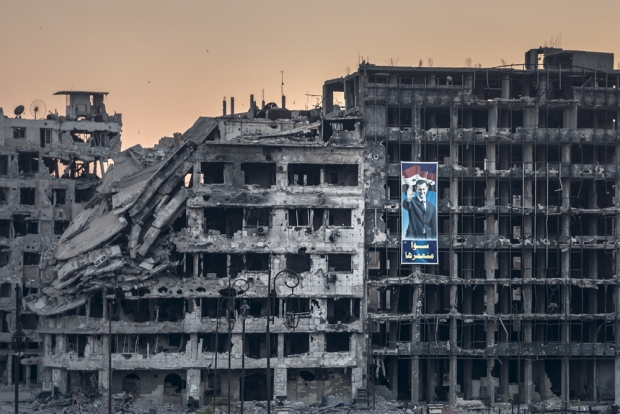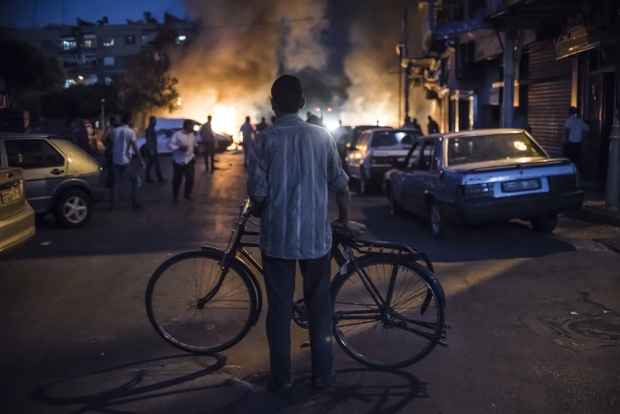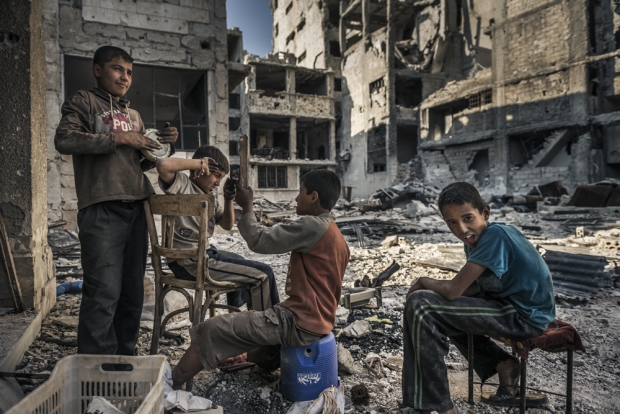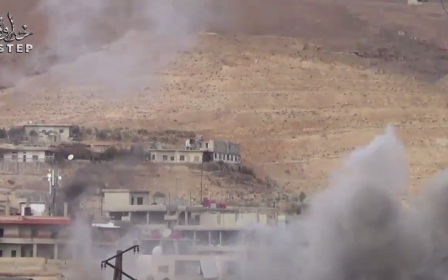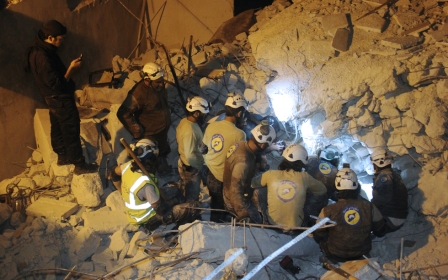Hope amid barrel bombs: London museum explores Syria's war

A green steel barrel loaded with explosives and petrol and crammed with bullets, screws, off-cuts from broken machinery - anything metal and sharp - lays bare the crudeness and cruelty of a war in which hundred of thousands have died.
But this "barrel bomb" is far from Syria. It is a representation that sits in the Imperial War Museum in London as part of Syria: A Conflict Explored, a season of public events and two exhibitions reflecting the ongoing conflict.
The weapon, that has become synonymous with the government of Bashar al-Assad, is just one of several installations that tell the story of the conflict.
There is also a helmet worn by a member of the White Helmets organisation, which has saved thousands of lives in rebel-held territory; and newspapers with coverage of the murders by Islamic State Group of western hostages David Haines and Alan Henning.
A caption then tells us: "While the tragic murders of Western citizens have grabbed media attention, ISIS has been responsible for the deaths of many more Syrians."
The exhibition - which is co-curated by Dr Christopher Phillips, a Syria expert at Queen Mary University and Chatham House - sets itself the task of offering a "balanced and objective introduction" to the war.
But it can only achieve this by stripping everything down to its bare minimum.
There is little on the various ways ordinary Syrians have resisted and organised themselves in the face of conflict.
An installation film - set within a broken wall interlaced with Islamic geometric patterning - takes viewers just eight minutes to travel from 2011 protests in Deraa over the torture of teenagers caught spraying anti-government graffiti, to 2017 and a total war with 1,000 rebel opposition groups operating and a quarter of the world's nations pouring in.
The exhibition points out the conflict is as much a "war of narratives" pushed by different players as it is a conventional war: Some still doubt the extent of civilian casualties in the battle for East Aleppo, while veteran journalists who have spent most of their lives covering the Middle East have been quickly cast aside.
A panel of human stories takes visitors beyond tales of death and destruction, to other effects of the conflict.
A retired history teacher with a passion for ancient history laments: "I had a thousand books before the crisis. And I had been writing a book of my own. I lost every paper I wrote."
Another man, the president of the Syrian Youth council and from pro-Assad Latakia, comes under fire for organising a fashion show showcasing work of young Syrian designers. He responds: "We have to work on making life go on. We are working to keep the young people in this country."
Of Latakia, he says: "We have the feeling of the war but not the war itself."
'A lens on Syria'
Another glimpse inside Assad's strongholds come through the camera of Sergey Ponomarev. As a Russian, Ponomarev - whose photos have appeared in the New York Times - was one of the few photographers with access to parts of Syria held by the government.
He asks how journalists can distinguish between what they see and what the government has allowed them to see.
"How do you distinguish between reality and propaganda? But it is vital to remain objective. Just because people are in government-controlled areas does not mean they are living well or safely - or that they necessarily support the government."
His photographs show the human consequences of conflict rather than scenes of combat. They convey Syria's diversity but also show Syrians continuing to go about their lives in the face of harrowing circumstances.
In one, taken in 2013, an opposition mortar shell has just hit a car causing en explosion near the old town of Damascus. Ponomarev told MEE that shelling happened regularly in this part of town. Well-dressed men rush to put out the fire, a cyclist - possibly on his way home - jumps off his bike and watches. Life goes on.
I wish to return to Syria and still think this country is full of life despite the conflict
- Sergey Ponomarev, photographer
One photograph is of four homeless children living in the ruins of Homs, whose parents went missing or were caught on the wrong side of a established checkpoint when opposition forces pulled out in 2014.
The backdrop is of ruins and rubble, yet the children smile as they play in the rubble.
Ponomarev says there his hope among the despair.
"I wish to return to Syria and still think this country is full of life despite the conflict."
Syria: A Conflict Explored runs between 27 April and 3 September 2017 at the Imperial War Museum London. Admission is free.
Middle East Eye propose une couverture et une analyse indépendantes et incomparables du Moyen-Orient, de l’Afrique du Nord et d’autres régions du monde. Pour en savoir plus sur la reprise de ce contenu et les frais qui s’appliquent, veuillez remplir ce formulaire [en anglais]. Pour en savoir plus sur MEE, cliquez ici [en anglais].


